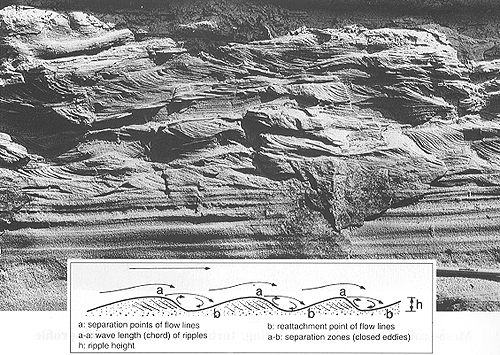
Close-up of a bed: internal structures
Plate 8

Close-up of a bed: internal structures
Plate 8
Sedimentary structures can be easily discerned, up to the individual lamina, when looking at beds from a close distance. Laminae are depositional units and, at the same time, sedimentary structures. Their spatial aggregation and arrangement creates, in fact, peculiar geometries and morphologies within a bed. In this case, observe the passage from thick, plane-parallel lamination in the lower part of the bed, to asymmetrical cross-lamination in the upper part, where the laminae become also thinner. The parallel laminae indicate the vertical growth of a flat depositional surface where sand was supplied; the cross laminae do not interrupt this growth but mark a change from a flat to a rippled bottom. The ripples migrated down flow (to the right) and were continually buried under the accumulating sand and reformed on top of it. The sand was dragged along the bottom in both cases, before coming to rest; a tractive current was responsible for that. Tractive structures will be examined in a special section; what is remarked here, is the fact that the vertical succession of the two types of lamination is not haphazard. It indicates that the current, while forming these structures, was decelerating. How can one say that? If you look at the sediment grain size, you will note it is coarser near the bottom, then fines up (see table 2). The size of particles is function of the current velocity, so it is clear that the current slowed down during deposition. When the speed was still relatively high, ripples could not form; only a flat bottom was hydrodinamically stable. Hydraulic sorting of grains in the bed load grouped them in strips and "carpets" moving at slightly different velocity because of differential friction. Distinct laminae thus formed, each showing a particular textural signature.
When ripples start to grow, the bottom exerts a greater friction on the current and the mechanism of sand traction is modified: the grains climb the upcurrent (stoss) side of ripples, then slide down the slipface forming the lee side. Foreset laminae accrete down flow and cause the ripple to grow laterally. The sand grains are then buried by the newcomers and stop for a while, until the migration of the ripple form (with the stoss side bypassing the position previously occupied by the lee side) exhumes and entrain them again (see inset). This mechanism implies that the sand grains alternate motion with immobility, with the result that their average velocity is decreased in comparison with the flat bed condition.
The bed shown in the photo is again a turbidite (we linger in this world to stress both the interrelation of several aspects and the optimal display of various features of more general interest). The order of superposition of the two types of laminae is part of what is called a Bouma sequence, from the name of the sedimentologist who formalized it in 1962 (see more in plate 69). The same sequence, though with less detail, was recognized in the Thirties by geologists working in the Apennines, and used as a way-up criterion in tectonically complex settings, where the beds are frequently vertical (see plate 9) or overturned.
Marnoso-arenacea Formation, Sarsina, northern Apennines.